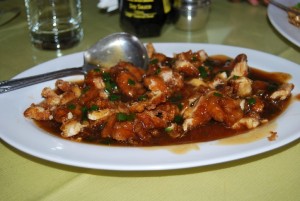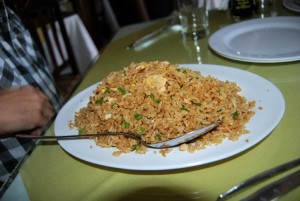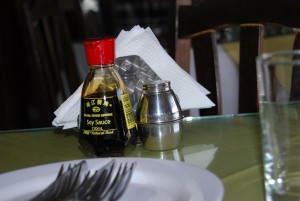The Unexplained Mystery of Chifa in Cuzco

Chinese food, called chifa, is one of the most popular foods in Peru. Benavides reports it comes third, following the inevitable pollo a la brasa (rotisserie chicken) and ceviche. As a result, one could argue that it is almost as Peruvian as the colors red and white. Despite this, in Cuzco its distribution is fascinating and telling.
Chifa is not simply Chinese food. It developed from the dishes of Canton brought to the country by Chinese Coolies in the nineteenth century. Once in South America, however, the food began a long process of Peruvianization.
At the same time ingredients such as soy sauce and ginger spread widely into the Peruvian population–their names in local Spanish are Chinese loan words, siyao and kion, while in other Latin American countries they are in Spanish, salsa de soya (soja) and jengibre–chifa kept its identity as Chinese instead of Peruvian, though it was localized.
The industry is fed by a constant flow of immigrants from Southern China to work kitchens in many chifas. Opening a chifa in Peru provides an overseas business opportunity at relatively low cost many Chinese seek.
Among other things, such as the development of a Chinatown in Lima and the widespread use of Chinese symbols in the restaurant, this movement of people from China to Peru keeps chifa identified with China, even though it may well be as much or more Peruvian as Chinese by now.

In major cities such as Lima one finds ma and pa chifas in almost every neighborhood where food is plentiful and cheap, even if the number of dishes fits only a small code. They include the ubiquitous wantan soup, and fried wantan, the tamarind chicken, the chicken roll, and tipakay or chijaukay chicken ( as well as the most popular dish of all, fried rice, called arroz chaufa, instead of the Spanish arroz frito. Nevertheless, Chaufa has escaped the boundaries of Chifas and moved into the Peruvian mainstream along with soy sauce and ginger. It can be found almost everywhere.

In Lima there are also more upscale restaurants with a wider variety of dishes and finer cooking. I have heard said that in Lima one can find some of the finest Chinese cuisine anywhere, as a result, along with outstanding Chinese chefs.
Cuzco presents a different picture. In much of the city chifas appear. Mostly they are of the ma and pa type, small locales with the standard set of offerings, along with a fixed price meal — a menu– that is often more Peruvian than Chinese. Nevertheless there are more established and more elaborate venues. None of the chifas of Cuzco, however, approach the fine Chinese venues of Lima.
Many of these chifas–I cannot say most without some sort of survey being done– have Peruvian staff and Peruvian owners. The skills of preparing Chinese food have been standardized and spread into the population to such an extent that the cooks do not need to be Chinese. But many still have cooks and owners speaking in the flat and drawn out voices of Canton, Guangdong in today’s spelling.
However, in the Colonial core, the center of tourist Cuzco and the location of its finest restaurants, chifa is almost absent. It is only fond on the periphery.
For some reason, the restauranteurs and entrepreneurs who invest in restaurants in Cuzco have not invested in the idea of chifa as something Peruvian and hence worthy of the gastronomic boom, nor have they invested in chifa as something interesting to tourists. This is the case, even though chifa forms part fo the raw material from which chefs such as Gastón Acurio build their renowned novo-Andean cuisines.
As a result, if one wishes to try this unique Peruvian variety of Chinese cuisine, one must go to the edges of the Colonial core. One can go to Marquez 208 Chinese Food, Q’uera 251 for Chifa Sipan or Quera 252 Wuaseng, Garcilaso 806-2 for Chifa Shanghai, Tullumayu 775 for Chifa Lymy, Pardo 789 for Chifa Kiwi, Plateros 380 for Chifa Sichuan, etc.

This is a fairly new development. Not more than a decade ago chifa was offered on the main square. Only with the recent boom in investment in Cuzco restaurants has chifa been pushed out.
As a result, Cuzco lives a divided reality. Chifa is wildly popular in it neighborhoods and districts where the people who work taking care of tourists live. But it is almost not available to the tourists, unless they go out of there way. There is one Cuzco for the locals, and a different one for tourists.

Furthermore, restaurant developers have yet to see any possibility in chifa for profits in Cuzco, despite the boom in Peruvian gastronomy. This may be because chifa, despite being almost as Peruvian as lima beans (pallares) carries still a classification as exotic and Chinese.
Perhaps, before to long some restauranteur will see this gap and open a fine, Peruvian chifa with up-scale food for well-heeled tourists, maybe one with an image of the Inca Pachacutec using chopsticks. Or maybe, the Peruvianness of the food will be forgotten and it will just be one of the many international cuisines offered in the city.




